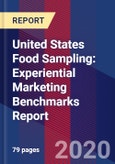The Food Sampling: Experiential Marketing Benchmarks Report details consumer reach, impact, and return-on-investment benchmarks for marketing activations completed for brands in the CPG Food segment. When it comes to marketing products in the CPG Food category, there is no better way to gain consumer insights than by letting them try the product for themselves. Traditionally, the most common forms of CPG Food sampling have come from conventional retail outlets and the company itself. Experiential has rapidly become another avenue for CPG brands to sample their products.
Benchmarking metrics represent data from multiple experiential marketing campaigns combined in different ways to serve as a point of comparison. Benchmarks for this report consist of data derived from 36,186 consumer exit interviews conducted at 6,050 events (84% Wet Sampling) where a CPG Food brand was sampled. The data from onsite consumer interviews are combined with field staff recap insights to form the basis of the data used in this report. Benchmarks gathered from this report showcase how consumer insights could be applied across all brands in the food sampling category.
Data collected for this report comes from an estimated 22,106,909 consumers who attended food sampling event venues. A total of 3,442,531 food sample distributions were used to compile data into this report. The comprehensive CPG Food category includes Bread & Bakery; Canned Goods & Soups; Condiments, Spices & Baking; Dairy, Eggs & Cheese; Frozen Foods; Grains, Pasta & Sides; Meat & Seafood; Cookies, Snacks & Candy (i.e., Candy, Cookies, Edible Cookie Dough, Ice Cream, and Snacks).
Table of Contents
Methodology

LOADING...








